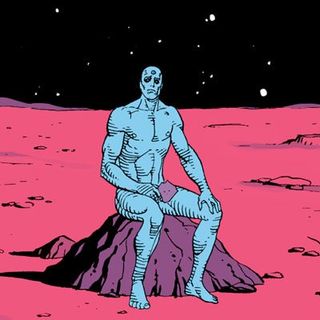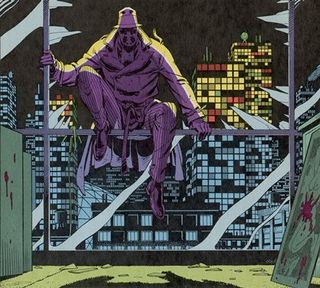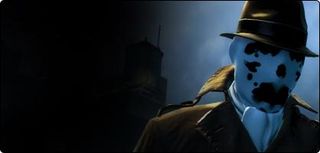And two days from now, one of the most complex stories of the modern era will hit theatres. It took Hollywood twenty-something years to film the unfilmable, after a series of multiple writers and directors signing on and leaving the project. And if you’re reading this, then you’re aware that Part 1 of the Watchmen prequel arcade game - The End Is Nigh - is available on XBLA and PSN.
So why are we here? Well, if you know absolutely nothing about the franchise or need a quick refresher course in Watchmen lore, we’re here to prime you in all things Rorschach, prime you for the first blockbuster of 2009 and add insight into the existence of the arcade game.


Set in an alternate history of America in the mid-80s, a number of key things are different. For one there are superheroes. In addition, Richard Nixon is currently serving his fourth term of presidency, stemming from the US victory in Vietnam. Add to that the growing hostilities between the Soviet Union and America and you have a world ready to implode.
Someone has killed The Comedian. The beginning of the comic explores the vicious murder of one of two government-licensed superheroes, former member of the Minutemen and Watchmen, Edward Blake. Rorschach - former Watchmen and current sociopath - plays detective and meets with all former members of the Watchmen before the Keene Act required they resign from public duty.
Among former teammates: the second Nite Owl (a gadget-obsessed, now impotent middle-aged man), Ozymandias (smartest man in the world, now one of the wealthiest), the second Silk Spectre (an ass-kicking lady taking after her mother) and the omnipotent Dr. Manhattan (who can change his and anyone else’s matter at will, including teleportation).

In a nutshell (that won’t do the comic any justice), Rorschach’s investigation into the Comedian’s death is a jumping-off point to discover the layered complexities of each character. Dr. Manhattan is a literal Superman, America’s leading edge in the Cold War against the Soviets. Manhattan is also emotionally detached from every living being on the planet, including his girlfriend the Silk Spectre.
This detachment and accusations that he has given a number of people cancer leads him to seek solace on Mars (yes, the planet). Meanwhile, an assassination attempt on Ozymandias’ life pushes Rorschach and the Nite Owl to question exactly why the former Watchmen are being bumped out of the way. Add to that the fact that with Manhattan out of the way, the Soviets feel comfortable enough to invade Afghanistan and push the limits of their power against the US. That’s all we can say without pushing into deep, deep spoiler territory. Unless… you want to know more.

Seriously, we’re about to give the whole thing away.
Turn back. You’ll be sad if you keep reading.
Ok, here’s the big reveal! You were warned!

With mounting tension in the Cold War, Nite Owl and Rorschach uncover a conspiracy that links the death of the Comedian to the mounting tensions of the Cold War. You see, Ozymandias put out a hit on himself as a red herring to lead people away from the fact that he’s planning something so outrageous and terrible that it will link the US and Soviets together in unison… namely a staged alien invasion of New York.
Ozymandias hired scientists and artists to combine strands of DNA from animals to create a squid-like monster, which he “warps” into New York, killing millions and leaving a wave of destruction. Yes, millions are dead and the Big Apple is destroyed. But because of a perceived threat on the world, The Soviets and Americans drop their petty Cold War and join forces against this new “threat” (which of course doesn’t exist). What’s even more interesting is how this plan was enacted by Ozymandias without Manhattan’s involvement. And once Manhattan learns of the plan, he submits because of the bigger picture. Wouldn’t you rather kill millions to save billions?
Place in history
We let GR staffer Henry Gilbert tell us exactly why the Watchmen comic is so damn important. Take it away, Henry!
Watchmen has been praised both inside and outside of the comics industry. In 1988, Watchmen won a Hugo award - for an achievement in sci-fi/fantasy literature, Time magazine declared Watchmen one of the 100 best English-language novels and Entertainment Weekly said the comic was the number 13 best novel printed in the last 25 years.
So why is Watchmen so damn important? Well, as stated earlier, Watchmen is a comic about comics, a simultaneous celebration of the medium while deconstructing popular conventions and archetypes.

Some comic fans have said that 1986 was the end of superhero comics, or at least an end.That year's seminal Dark Knight Returns, which concludes with the death of Batman (though not Bruce Wayne), and the last heroes in DC disappearing, was the death of the superhero. And coming out the same year was Watchmen, which is the funeral for that death. Like a memorial it looks back at its history, its many milestones and what it meant. But that sad view is incredibly short sighted: comics has endured nearly 25 years since then, and in both DKR and Watchmen this dissection of concept was followed with a rebirth and rebuilding of the form that the mainstream comics media hasn't completely recovered from.
Deconstruction and analysis is at the heart of Watchmen, whether it’s the nihilistic insanity of an unstoppably driven man like Rorschach, the gradual separation from humanity that god-like powers give Dr. Manhattan, the deeper sexual desires guiding the needs of Nite Owl and his resulting impotence, the love/hate one feels for their parents in Sally Jupiter, or the desire to save the world by the earth's smartest man resulting in mass murder. It places heroes in the "real" world we know and lets us see how they would affect society and how society would push back at these individuals.

To say Watchmen changed everything is too straightforward and simplifies comics down to one genre. However, mainstream super comics were deeply changed and to this day DC and Marvel take much from it. But to paraphrase Alan Moore from an interview, he wishes more artists would have taken inspiration from it stylistically and in the changes in storytelling than just the grim mood. Because in less obvious ways Watchmen altered the medium in its design, from page layout to covers to timing and even its narrative structure was revelatory thanks to the reality that drips from the lines that Dave Gibbons infused in the art.

